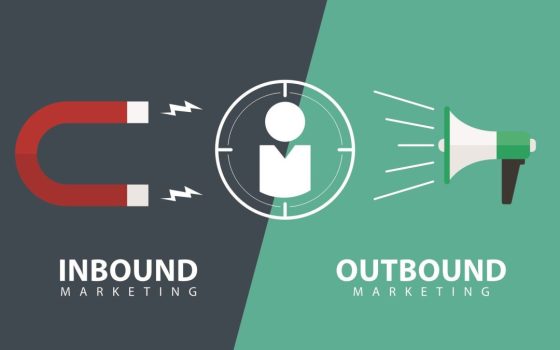Inbound marketing is hard work, and results come in slowly. Why do it at all? It’s as simple as this one undeniable reason.
If you’ve been following my blog for any time at all, you know that I’m a big proponent of inbound marketing.
I mean, you can see that right off the bat with this blog.
I don’t just sell inbound marketing – I’m a client!
Of course, I do use outbound marketing techniques too.
No enrollment marketing strategy would be complete without outbound marketing included.
Yet outbound marketing never needs explaining or promoting.
Enrollment marketers know instinctively that they’ve got to find ways to get their marketing out in front of new prospects to expand brand awareness.
So outbound print advertisements, digital ads, and social media advertising are never in short supply.
That is why I talk more about inbound marketing in my blog.
This is the “opportunity for improvement” for most independent schools, colleges, and universities.
Inbound marketing is not easy.
It’s not necessarily expensive. But it requires a lot of work, consistency, and strategy.
Even more challenging, results come in slowly.
For example, it took me about a year of blogging consistently before the results began to come in. Now, I have inquiries and new projects that come in directly because of the content I create.
But in that first year, it was easy to get discouraged and wonder if I could spend my time better somewhere else.
Although it isn’t easy, I believe every enrollment marketing plan must have an inbound strategy.
Why? For one undeniable reason.
As human beings, we like to shop. We hate being sold to.
Most of us have a bad view of salespeople.
In fact, just saying the name “used car salesman” can be a way to offend someone.
The truth really is that there are good and bad salespeople just like any other profession.
Unfortunately, some salesmen and women have earned their bad reputation.
Some shady characters have lied to customers about the merits and abilities of whatever product or service they’re selling.
Others have used dubious “bait and switch” tactics to get us to a sales presentation, like inviting you for a friendly dinner when they really just want a chance to present their product.
We know they’re not all bad, but we’ve got our reasons for being wary of salespeople.
Even so, we still LOVE to shop.
Shopping is one popular way for people to celebrate, de-stress, or bond together. But we don’t like sales people.
Strange, isn’t it?
What’s the difference?
When we shop, we are exploring new products and services that can make our lives better.
In shopping, we initiate the process. We control the journey. We’ve got the power.
But when we’re being sold to, our sense of control disappears.
When we’re being sold to someone else who doesn’t know us – neither our needs or our desires – is pulling us into a transaction we didn’t want in the first place.
In this dynamic, the salesperson initiates the process.
They control the journey. They’ve got the power.
(Now I’m not saying salespeople are malicious – not at all! But the out-of-control sense you feel when you’re being sold to, naturally makes you suspicious.)
Thoughtful salespeople can do a lot to navigate this reality by asking questions, answering straightforwardly, and making honest recommendations.
However, no matter what salespeople do, suspicion lingers in the back of our minds.
Do they really have my interests at heart?
Are they telling me the whole truth so that I have a complete picture of what this product will be like in my life?
What’s in it for them?
This is an inherent weakness with outbound marketing, too.
Outbound marketing pushes a transaction that your prospective student wasn’t looking for.
Most prospective students or parents don’t start browsing the Internet thinking to make a deposit that very day.
More than likely, they went on the Internet in search of answers for questions they have that are related to their education decision.
- How do I choose a career?
- What do I need to do to prepare for my college education?
- How do I pay for college?
- How much does this education cost?
- What do I need to be successful in my chosen field?
- In what ways does an education improve my life outside of my career?
These are just a few of the hundreds of questions that prospective students have before they choose a school.
When they go on the Internet, they want to shop.
They do not want to be sold to.
Inbound marketing is how prospective students shop for you on the Internet.
When people shop, they’re looking for answers to their questions.
They’re looking for solutions to their problems, or a way to achieve their goals.
When you have an active, consistent inbound marketing strategy, you’re providing prospective students a way to shop for you.
With inbound marketing, the prospect initiates the process. They control the enrollment cycle.
Inbound marketing respects the fact that the prospective student is ultimately in control.
The core philosophy behind inbound marketing is this:
Answer the most pressing questions prospective students have in an honest, transparent, and attractive way before they even ask. Over time, this servant-hearted approach will attract many more students to the education brand than outbound can do alone and deepen brand loyalty. Thus, more prospects eventually become enrolled students.
Being sold to produces suspicion naturally. Answering questions, as prospective students shop, creates trust naturally.
In the end, your enrollment strategy needs a healthy blend of both outbound and inbound marketing.
You can raise awareness through outbound tactics, but it is your inbound marketing tactics that will create the trust and loyalty you need to move prospective students through the enrollment cycle.
Featured image by Ananaline via Adobe Stock
Click here to read this article on the Caylor Solutions website.





